|
Alfa-Romeo
|
1906 |
Country: |
 |
|
NO ITALIAN sporting car has a pedigree as long and distinguished as Alfa Romeo, yet the famous Milanese marque had a humble and unusual origin, owing its existence directly to the failure of a French industrialist to market his taxicabs successfully in Italy.
During 1905 - 1907 the Italian market was very favourable to overseas investment, and several French and British makers established themselves there for a while. Always keen to find extra outlets for the products of his factory at Suresnes, Paris, Alexandre Darracq yielded to the advice of his Rome and Turin agents to get a foothold in Italy and created the Societa Italiana Automobili Darracq, at Naples, in 1906.
It was here that cars were assembled using parts shipped from Paris. The company soon learned that Naples was a long way south of industrial Italy and its accessible labour and natural resources, and decided to move north to Lombardy. A site was found at Portello, outside Milan, and a new factory was built for the manufacture of Darracq single and twin-cylinder cars and taxis.
M. Darracq himself came to supervise production arrangements, but his company, unappreciative of Italian needs, tried to push underpowered, poorly braked vehicles onto a market where the hilly, winding roads made ample power and efficient braking prime essentials. So the Darracq taxis were a flop and, with the serious international trading slump of 1908 as an extra worry, Alexandre Darracq was ready by 1909 to admit his mistake and close down the Italian factory.
However, several motor-minded industrialists from Milan saw promise at Portello and, forming a group with financial aid from the Banca Agricola di Milano, took over Darracq Italiana. Once in possession they made a swift appraisal of their resources, and in 1910 reformed the company as the Societa Anonima Lombarda Fabbrica Automobili (Lombardy Motor Manufacturing Co), or ALFA for short, with the intention of making an all-Italian car.
For the company's trade mark they combined the coat of arms of the City of Milan, comprising the cross of St George, and the somewhat gruesome arms of the ancient Sforza family of Milan, depicting a snake seemingly swallowing a small boy. As designer, they hired Giuseppe Merosi, who was formerly with Marchand, Fiat and Bianchi, and his first efforts produced a series of monobloc four-cylinder side-valve cars in 12 hp (2.4-liter) and 24hp (4.1-liter) forms which were sturdy but lively machines and established the new marque on a sound footing.
Alfa quickly betrayed its sporting tendencies by running two of the 24 hp cars in the 1911
Targa Florio race over the Sicilian mountains. Both retired, but not before one, driven by the chief works tester Franchini, had led the race - a good omen destined to be fulfilled a hundred-fold in the future. The next design from Merosi's drawing board further pointed the way Alfa was going - it was the powerful 40/60 of 6.1 liters, distinguished by overhead valves operated by rockers and pushrods from twin camshafts high in the crankcase - a vertical-valved anticipation of the famous Riley layout of 1926.
This big bi-block unit produced 73 bhp at 2000 rpm. It ran at over 75 mph in 1913, and two 40/60 Alfas driven by Franchini and Campari took 3rd and 4th places in the 1914 Coppa Florio race. A further surprise from Portello was a genuine 1914 Grand Prix racing car with a most sophisticated twin overhead-camshaft, 4.5-liter, four-cylinder engine in a 40/60 chassis. Nothing was known of this Merosi-designed car outside Italy for fifty years - a striking example of a gallant failure kept secret. Its output of 88 bhp at 3000 rpm in a heavy chassis must have been disappointing, and although Alfacan only have built it with the 1914 4.5-liter Grand Prix Formula in mind, it was never entered for that race and the assumption of many automotive historians is that Portello decided to withhold its racing debut until it was further developed.
The outbreak of World War 1 foiled that plan, and as it was obsolete after the war the first Grand Prix Alfa had comparatively little exercise. Its one moment of glory came when Campari made the fastest lap at Brescia in 1921, where it was timed at 94.69 mph through a kilometre before its radiator burst and it retired. War diverted Alfa's efforts to more martial things than cars, but the most important development was the acquisition, in 1915, of a new proprietor - a shrewd industrialist named Nicola Romeo. His diverse interests included the making of air compressors, mining machinery, railway rolling stock and gear, tractors, munitions and numerous other commodities, and in 1918 the old Alta concern was refloated as the SA Italiana Ing Nicola Romeo, with carte blanche from its patron to resume building sporting cars as soon as peace returned.
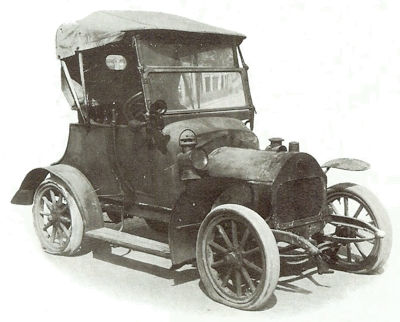 This photo is NOT an Alfa, but a Darracq manufactured in Portello using parts shipped from Paris. It's lack of power and poor brakes doomed it from the start.
This photo is NOT an Alfa, but a Darracq manufactured in Portello using parts shipped from Paris. It's lack of power and poor brakes doomed it from the start.
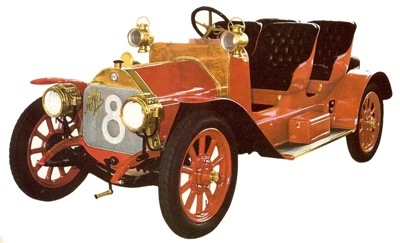 1911 Alfa 12hp - the first from the drawing board of Giuseppe Merosi. It used a monobloc four cylinder side valve 2.4 liter engine and was soon enjoying success on race circuits. It was also available as a 4.1 liter 24hp version.
1911 Alfa 12hp - the first from the drawing board of Giuseppe Merosi. It used a monobloc four cylinder side valve 2.4 liter engine and was soon enjoying success on race circuits. It was also available as a 4.1 liter 24hp version.
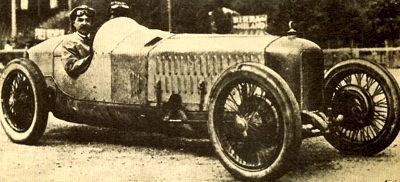 1923 Alfa Romeo P1 Grand Prix was designed by Merosi. Due to a practice accident at Monza, in which Ugo Sivocci (at the wheel in this picture) was killed, the car was never raced.
1923 Alfa Romeo P1 Grand Prix was designed by Merosi. Due to a practice accident at Monza, in which Ugo Sivocci (at the wheel in this picture) was killed, the car was never raced.
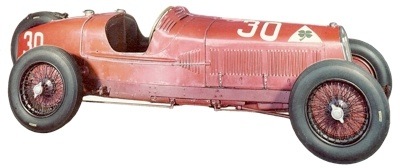 The Alfa Romeo P2 Grand Prix car was specially modified by the factory for the 1930 season. It would win the Targa Florio that year, in the hands of Achille Varzi, who broke the average speed record for the race.
The Alfa Romeo P2 Grand Prix car was specially modified by the factory for the 1930 season. It would win the Targa Florio that year, in the hands of Achille Varzi, who broke the average speed record for the race.
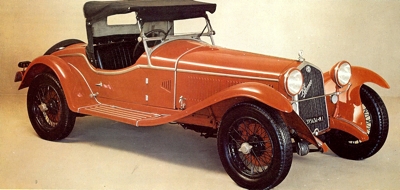 1930 Alfa Romeo Grand Sport, which was produced with various single and twin-cam supercharged and normally aspirated froms during the 1920s and 1930s. A 1750cc version could manage 90 mph, which for the time was brilliant.
1930 Alfa Romeo Grand Sport, which was produced with various single and twin-cam supercharged and normally aspirated froms during the 1920s and 1930s. A 1750cc version could manage 90 mph, which for the time was brilliant.
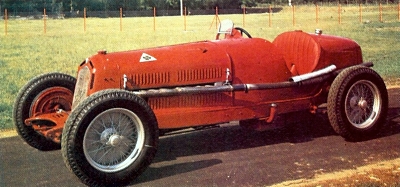 The Alfa Romeo 8C 2300 was raced between 1931 and 1934.
The Alfa Romeo 8C 2300 was raced between 1931 and 1934.
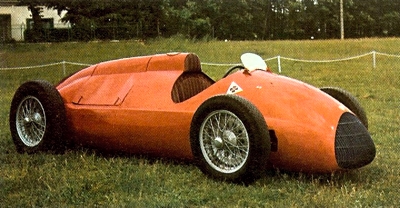 1939 Alfa Romeo 512 Prototype. Designed by Wilfredo Ricart, it was produced during 1940 - 1941, and was designated as the 512. Powered by 335bhp 1490cc supercharged flat-twelve only 2 were built, but were never raced.
1939 Alfa Romeo 512 Prototype. Designed by Wilfredo Ricart, it was produced during 1940 - 1941, and was designated as the 512. Powered by 335bhp 1490cc supercharged flat-twelve only 2 were built, but were never raced.
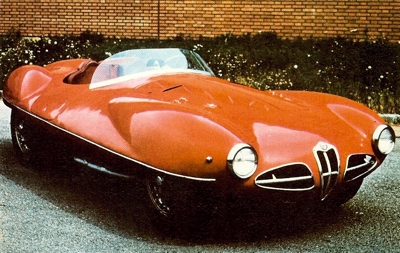 1952 Alfa Romeo Disco Volante Spider, which was fitted with a 1900cc engine. Purely developed as a publicity exercise, it was designed by Touring to bring the Alfa Romeo name back into the headlines.
1952 Alfa Romeo Disco Volante Spider, which was fitted with a 1900cc engine. Purely developed as a publicity exercise, it was designed by Touring to bring the Alfa Romeo name back into the headlines.
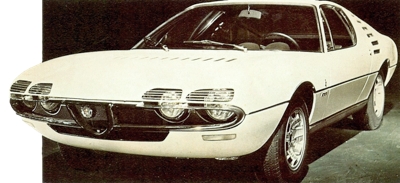 For six years the Montreal was the flagship of the Alfa Romeo range. Its race-bred 2.5 liter V8 gave a top speed of 137 mph, coupled with rapid acceleration.
For six years the Montreal was the flagship of the Alfa Romeo range. Its race-bred 2.5 liter V8 gave a top speed of 137 mph, coupled with rapid acceleration. |
These cars were to bear the name Alfa Romeo, and motoring circles of the time likely had little idea of the ambitions nurtured by the new marque. A successor to the 24hp, the 4.2-liter four-cylinder 20-30, went into production in 1920, followed by the more sporting 20-30 ES in 1921, and a large, uninspiring six-cylinder, the 6.3-liter G1. At the same time the nucleus of a racing team was formed, comprising Giuseppe Campari, Antonio Ascari, Ugo Sivocci and Enzo Ferrari. Their first mounts were the old pre-war 40-60s and the smaller 20-30s, and it was with a 40-60 fitted with an overhead-valve head that Campari scored the first outright Alfa race victory in the 1920 Circuit of Mugello, near Florence.
A few weeks later Enzo Ferrari came second in the Targa Florio, and in 1921 Campari, Ferrari and Sivocci capped Alfa's 1920 Mugello success by scoring a resounding 1-2-3 win there. In late 1921 a new Alfa Romeo, the 3-liter six-cylinder pushrod overhead-valve RL, was introduced, both in touring and sports forms. From the latter a good looking racing machine was evolved for the 1923 season, and Portello's racing fortunes rode their highest yet when, after six tries, victory came at last in the Targa Florio at the hands of Ugo Sivocci. This was backed up by first places at Cremona by Ascari, at Savio by Ferrari, and at Mugello by Count Masetti, but in September came a sombre note. A new Merosi-designed six-cylinder, twin overhead-camshaft 2-liter Grand Prix car called the P1 had been built for the European GP at Monza. During practice for this race Sivocci crashed his P1 and was killed. Nicola Romeo immediately withdrew his other cars, and the P1 was never again raced.
But if Alfa's second attempt at a Grand Prix car was another failure, the third was a sensational success. Enzo Ferrari had persuaded Vittorio Jano, designer of the successful GP Fiats, to join Alfa Romeo. The result was the 2-liter straight-eight supercharged P2 Alfa Romeo of 1924. This classic design won its very first race, the Circuit of Cremona, driven by Ascari, and its very first Grand Prix, that of France, at Lyons, driven by Campari, thereby elevating the new Alfa Romeo to the very peak of racing accomplishment on its first appearance outside Italy. It did even better in the subsequent Italian GP: Ascari, Wagner, Campari and Minoia scored an epic 1-2-3-4 victory.
In 1925 P2s took the first two places in the European GP at Spa, Belgium, with insolent ease, and would almost certainly have won the French GP again but for the fatal accident to Antonio Ascari while leading the race. His car slid an inch or so too far on an unexpectedly wet corner at the Montlhery circuit, a hubcap tangled with the wood paling fence, and the car overturned into a ditch. As a result the remaining Alfa Romeos were withdrawn. They completed the season, however, by winning the Italian GP again, the cars this time occupying rst, 2nd and 5th places. The P2 works team was then disbanded, but these famous cars were soon circulating on the race circuits again, but this time in private hands, right up to 1930, winning several Italian road races and scoring a final victory in the 1930 Targa Florio.
Lessons From The Track Used To Create Outstanding Production Vehicles
While Alfa Romeo thus became a world-famous name in racing, the lessons of the track were applied by Jano to an outstanding series of road cars extending from the mid-1920s to the mid-1930s. They began in 1927 with a single overhead-camshaft 1.5-liter six-cylinder touring car, followed in swift succession by a 1750cc single-cam, and 1500cc and 1750cc twin-cam models, with and without superchargers. The workmanship and finish of these Jano sixes was sheer artistry, and their performances confirmed them as among the world's classic designs, accentuated by some superb Italian coachwork executed by such masters as Castagna, Touring and Zagato.
Inevitably the twin-cam sixes were raced and, equally inevitably in a period when Grands Prix were eclipsed by sports car races, they won. Almost everywhere the red Alfas went - Belgium, France, Britain, Ireland, Spain and, of course, their homeland, they won races, their score including three Mille Miglias, two Belgian 24-Hours, the Boulogne and Irish GPs and the Ulster TT. They were succeeded by Jano's 2.3-liter super-charged straight-eights, having the same bore and stroke as the 1750, but distinguished by central gear drive to the twin overhead-camshafts. The '2.3' carried the Alfa torch to even greater success, their many triumphs including four Le Mans 24-Hour races in a row from 1931 to 1934, and three Mille Miglias, while the same basic engine in a shorter racing chassis ran in Grands Prix as the 'Monza' Alfa from 1931 to 1934, scoring several more wins, including three Targa Florios and the 1931 Italian GP.
Meantime Alfa Romeo's production road cars, six and eight-cylinder models ranging from sober saloons to intoxicating supercharged 'spiders', were enhancing Portello's reputation still further, while the company was now also engaged in the construction of aero-engines, buses, trucks etc. Nicola Romeo retired in 1930 - he died in 1938 - and the company was re-floated as the SA Alfa Romeo, with a Government grant to assist it. With so many commitments, however, it found itself short of working capital and, in 1933, it passed under the control of a Government industrial reconstructional organisation called the IRI.
None of the behind-the-scenes activities seemed to affect Alfa Romeo's racing activities, nor the run of success. Under the spur of Mussolini's nationalistic regime and his frequent 'Race and win for Italy' orders by telegram, Alfa victories continued. In 1932 Jano produced a worthy successor to the P2 Grand Prix car in the Tipo B 'Monoposto', commonly called the P3. This superb racing machine had a super-charged 2.6-liter straight-eight engine based on the 'Monza', but with twin superchargers, a single-seater body and a classically purposeful appearance. With master drivers such as Nuvolari, Caracciola, Chiron and Fagioli, it swept all opposition before it, winning seven GP-type events in 1932 and six in 1933.
Nuvolari Defeats 9 Germans
The engine was enlarged to 2.9 liters in 1934, when the P3 won 15 races, and to 3.2 liters for 1935, when it won 13. By then, however, the German challenge by Mercedes-Benz and Auto Union had taken full effect, and the Monoposto's later successes were in lesser races, apart from Nuvolari's most famous victory of all, the 1935 German GP in which he defeated nine German cars. A more modern, all-independently sprung GP car appeared late that year, at first with a 3.8-liter eight-cylinder engine, but in 1936 with a 4.4-liter V 12 unit.
Allied to the genius of Tazio Nuvolari, this car brought Alfa Romeo several more victories, including the revived Vanderbilt Cup race in America. But by 1937 the German cars had gained total domination. For the 1938 3 liter GP Formula Portello half-heartedly built eight, twelve and sixteen-cylinder cars with small hope of success, but they also adapted one bank of the sixteen-cylinder design to produce a 1.5-liter straight-eight supercharged voiturette racer. This was at the instigatiorr of the Scuderia Ferrari, which ran Alfa Romeo's racing for them from 1933 to 1938. Designed by Gioacchino Colombo, the car was called the Tipo 158 and nicknamed the Alfetta. It won two races in 1938, its first year, and four more in 1939-1940 before war interrupted a career destined to make indelible racing history.
Many features used by Alfa in racing, such as the very effective independent suspension, were inherited by the sports and touring cars produced by the company. A 2.3-Iitre six called the 6C 2300 was the basic production model in the last years before the war, while the 8C 2900 supercharged eights set standards for performance and appearance hard to equal; the 1938 Mille Miglia-winning car with light alloy 'Superleggera' open two-seater bodywork by Touring remains a classic shape today.
World War 2 intruded dramatically on Alfa Romeo car development, and the company returned to peace with the famous Portello factory three- quarters destroyed. Despite this the company contrived a remarkable recovery, even to the extent of resuming Grand Prix racing. In 1946 the Tipo 158s embarked on a five-year period of total GP domination, undergoing such development between then and 1951 that their engine.output rose from just under 200 to over 400 bhp; they won over 25 post-war GPs and brought Farina the first World Drivers' Championship in 1950, and Fangio the second in 1951.
On the all-important production side, Alfa Romeo reappeared in 1947 with a modernised 2.5-liter version of the prewar six called the 'Freccia d'Oro' (Golden Arrow), which lapsed from normal Alfa standards in having a steering column gearchange and somewhat garish styling. 1950 brought a radically different car, the 1900 saloon aimed at a mass market; it was Alfa's first four-cylinder model for 25 years, and the company's first with integral chassis/body construction. Designed by Alessio, it retained Portello's famous twin overhead camshafts, but the independent rear suspension of the 1930s gave way to a rigid axle with coil springs and very carefully triangulated location.
1900 Super and Sprint versions followed, and in 1952 the remarkable 'Disco Volante' (Flying Saucer) appeared. This prototype had very distinctive 'ogival' bodywork by Touring, and was a clever publicity exercise - although it never went into production. Alfas had at last withdrawn from Grand Prix racing after 1951, following 30 years' intensive support, but they could not resist at least a dabble in racing, and besides successful forays in the touring classes with production-based models, the company evolved competition versions of the Disco Volante, without the exotic bodywork and with a larger six-cylinder engine. Driven by Fangio, these cars scored a 2nd place in the 1953 Mille Miglia and won that year's Supercorte-maggiore GP at Merano.
The next important Alfa Romeo was the Giulietta of 1954, a most comely little 1300 cc twin-cam four in two-door coupe and four-door berlina versions. Higher performance editions, and Pininfarina, Bertone and Zagato-bodied variants followed, and the popular Giulietta range lasted until the coming, in 1962, of the slightly larger Giulia with optional 1570 cc engine, 5-speed gearbox and disc brakes. Meantime the 1900 Super had been replaced by the 2000, and a larger model, the 2600 - with six cylinders and five speeds- also appeared. All came with confusing performance and bodywork options as Berlina, Super, Sprint, Sprint GT, Spider, Spider Veloce and so on; all had the famous twin overhead camshafts, and all were true Alfas in handling and performance.
Portello Replaced By Arese
The 1960s were an eventful decade for Alfa Romeo. In 1963 the company began erection of a vast new, manufacturing plant at Arese, outside Milan, to replace the ageing, inadequate Portello works. In 1967 it built an all-new 2-liter four overhead-camshaft V8 for sports car racing, the mid-engined Tipo 33. Raced for Alfa in prototype sports car events by the Autodelta organisation, this quickly grew into a 3-liter and, though often trouble-dogged, the 33 won the Targa Florio, Brands Hatch 1000 kms and Watkins Glen 6 Hours races in 1971.
For 1973 it was superseded by a new flat-rz 3-liter prototype, the Tipo 33-12. In 1968 Alfa introduced the 1750, a face-lifted Giulia with 1779 cc engine, and that same year-in answer to Government encouragement to extend the Italian motor industry to the South initial difficulties in getting established in a largely agrarian district, the Alfasud plant began production by late 1971 and the car has proved a worthy cousin to Alfa Romeo's current range of 2000 and Alfetta models in various forms.
One short-lived Alfa was the Montreal. Introduced in 1970, this was a high-performance coupe styled by Bertone with front-mounted Tipo 33 V8 engine in 2.5-liter road form, retaining the non-independent rear axle. The Montreal was discontinued in 1976. The 2000, which appeared in 1971, is basically a 1750 with larger bore 1962cc engine plus styling and interior refinements. The range included saloon and open 'Spider', models. The Alfetta, announced in 1972, was typical of the company's thinking and had a 1779 cc four-cylinder twin-cam engine, de Dion-type rear axle (incorporating the five-speed gearbox), torsion bar front suspension and rack-and-pinion steering. Its name derived from the famous 1.5-Iitre eight-cylinder Tipo 158/159 'Alfetta' racing car which, in its final 1951 form, also had a de Dion rear axle-cum-gearbox.
By 1979 Alfa would return to manufacturing true sporting masterpieces, such as the
GTV6. The engineering excellence of this vehicle, particularly the silky-sweet V6 engine, would help re-establish the reputation of this truely great automobile manufacturer.
Recommended Reading: History and Heritage of Alfa Romeo (Aus Edition) 